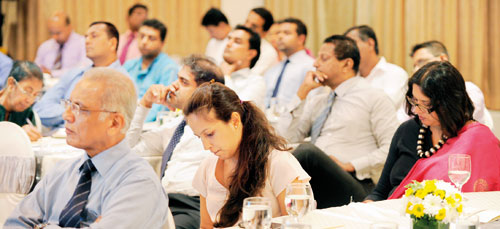Labour shortage seriously hinders the country’s development progress
 Noting that Sri Lanka’s industrial, construction and agricultural sectors would find it extremely difficult to grow speedily in the coming years, four eminent experts in the fields of education, commerce, human resource and immigration cautioned that a labour shortage would be a hindrance for the country’s swing towards speedy development.
Noting that Sri Lanka’s industrial, construction and agricultural sectors would find it extremely difficult to grow speedily in the coming years, four eminent experts in the fields of education, commerce, human resource and immigration cautioned that a labour shortage would be a hindrance for the country’s swing towards speedy development.
There is a huge shortage of both skilled and unskilled labour due to the unwillingness of people to join the industry and, on the other hand, seeking greener pastures.
Companies are facing problems to continue their work and as a result some of them have already gained permission to employ Indian and Chinese workers in small numbers on one-year visas, it was revealed at the Sunday Times Business Club (STBC) discussion on “Sri Lanka’s labour conundrum: Import or perish?” held at the Kingsbury Colombo on Tuesday.
Sri Lanka, it emerged, has not been able to cater to the demand for workers in mid-professional, skilled and semi-skilled job categories.
Labour is the basic input but most complex factor in any of the production processes. Therefore studying the labour market situation is very important for the economic growth of a country.
Revealing the results of a survey he undertook based on data from the World Bank enterprise survey 2011, Prof. Athula Ranasinghe, Dean of the Faculty of Arts, University of Colombo, told the gathering of STBC members and invitees that local firms are experiencing a 40 per cent shortage of skilled labour and this is predominantly in the Western Province.
 Divergent views on employment
Divergent views on employment
According to findings of this survey there were 58 per cent vacancies in the apparel sector, 20 percent in food, and 33 per cent in other manufacturing sectors.
The challenge arising out of labour shortage was high for dynamic firms, and more visible in large and medium scale firms, he disclosed.
Over 50 per cent of firms state that the system does not produce skills that are relevant to apparel sector. Moreover, about 33 per cent consider the lack of adequate skills as one of the major constraints on operating and growing their businesses.
He disclosed that government authorities have expressed divergent views on employment issues resulting in a major human resources dilemma at the Board of Investment (BOI) zones.
The BOI chairman, according to published reports, says that there are 200,000 job vacancies while State Minister Sujeewa Senasinghe claimed there are 50,000 vacancies but no takers.
He suggested the way out for this issue as mechanisation of production lines, labour importation, encouraging internal migration of labour, and the shifting of businesses to labour abundant areas.
However, Prof. Ranasinghe noted that while shifting industry to the countryside is good one must exercise caution as everyone knows the plight of former President Ranasinghe Premadasa’s 200 garment factories programme.
During the Q&A session he pointed out, the causes for this labour shortage problem as the absence of national skills development policy, lack of career guidance, inadequate number of training facilities in the job market and mismatch between technologies used in public institutions and in the industries influenced it.
 More incentives
More incentives
He emphasised the need of coordination between the private sector firms and schools to implement on-the-job training programmes for school leavers.
The government should provide more incentives for the private sector for this purpose, he added.
According to official data women, represent approximately 57 per cent of the total estimated population of 21 million in the island, but only 33.4 per cent contributes to the national economy from 8.5 million of an economically active population in the country.
Almost 70 per cent of the labour force constitutes economically inactive women. This is in spite of the fact that educated and qualified women outnumber men and large proportions of women attend management and accounts training programmes offered by private educational institutes.
But most of them were leaving their jobs after marriage to look after their children.
During the discussion, it was revealed that a large number of mothers, from the suburbs, accompany their children to schools and wait in school vans till the schools are over wasting at least five hours on roads which was a major loss in productivity.
Commenting on this issue, Prof. Ranasinghe said that” we will have to change the overall system and attitudes to make women more proactive”.
He added that “educated women contribute their share for the society although some of them are not engaged in gainful employment”.
Dinesh Weerakkody, Chairman of the National Human Resource Development Council of Sri Lanka stressed the need of bringing together business and labour, government and training providers, at the local, industry and national levels, as an effective means of securing the relevance of training to the changing needs of enterprises and labour markets.
The Vocational Training Institutes (VTI’s) are not catering to the needs of the private sector and therefore it is essential to re-orient those training courses in consultation with the private sector, he said adding that career guidance should be provided for youth at school level.
Plenty of jobs
He disclosed that at least 400,000 jobs are available in the hotel, tourism, and industrial sectors per annum.
Mr. Weerakkody revealed that there was a trend of increasing the number of voluntary unemployment in the country. Around 100,000 people prefer not to work.
He pointed out that workforce development, arming youth with the knowledge necessary for today’s knowledge-service driven economy is essential to equipped them with gainful employment.
However, importing talent could help to fill critical short-term skills gaps but a clear strategy is essential for growing our ‘own’ talent, he said adding that the right talent strategy can help the tourism, hospitality, and leisure and construction companies.
Export economies
The training of VTIs jointly with the private sector to upgrade the skills of their workforce has been crucial, since high-level skills are essential for manufacturing related activities, he pointed out.
Samantha Ranatunga , Chairman of the Ceylon Chamber of Commerce, was of the view that ‘we should not make too much of a fuss about labour imports’ as currently this seems the only, immediate solution to the labour shortage issue.
Sri Lankan youths are distancing themselves from agriculture and construction fields and the country has to look to its neighbouring countries to fill the gap, he argued.
Indian workers – some skilled combined harvester operators and others unskilled labourers – are willing to work during the time of the harvesting season for around 17 days, he disclosed.
These South Indians enter the country on a tourist visa and remain here for a month or longer moving from one farm to another. Sri Lankan farmers prefer Indian workers because they work hard, stick to deadlines and are cheaper.
Firms constructing Chinese government funded infrastructure projects employ thousands of people from that country, he said.
Sri Lankan workers should be given training on other vocations such as modern technology jobs so that they would be able to work in different fields if they lose their current jobs due to automation and modern technology.
Citing an example he said that in Malaysia, rubber tappers were given gainful employment in the electronic industry after completion of their training.
Referring to the entrepreneurship issue, he said that local banks should be more flexible in lending to up and coming entrepreneurs to find seed capital for their business ventures.
Nihal Ranasinghe, Controller General of Immigration and Emigration, noted that his department is acting as a facilitator and not controller in the labour movement to and from the country.
The department will issue resident visa, work visa and tourist visa for foreign workers considering the recommendations made by line agencies; he said adding that foreign workers are covered by the Immigrant Act.
Foreign labour to fill gaps
If international firms need foreign workers to fill the gaps and complete projects on time in accordance with their agreements with the government, the department will issue visas to them, he pointed out adding that line agencies should take the responsibility of their stay in the island.
Resident visas from one year to three years will be issued to foreign workers on recommendation of the BOI and other state agencies, he disclosed.


